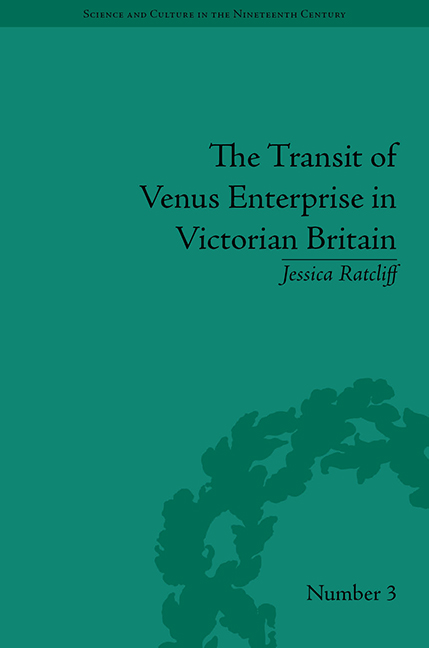Book contents
- Frontmatter
- CONTENTS
- Acknowledgements
- List of Illustrations
- Dedication
- Introduction
- 1 The Precedent: Transit of Venus Expeditions in 1761 and 1769
- 2 Big Science in Britain c. 1815–70
- 3 Noble Science, Noble Nation: The Establishment of Transit Programmes in Britain and Abroad
- 4 Inside Greenwich: The Preparations for 1874
- 5 The Expeditions
- 6 The Outcome
- Conclusion
- Epilogue: The Transit of 1882
- Notes
- Works Cited
- Index
Epilogue: The Transit of 1882
- Frontmatter
- CONTENTS
- Acknowledgements
- List of Illustrations
- Dedication
- Introduction
- 1 The Precedent: Transit of Venus Expeditions in 1761 and 1769
- 2 Big Science in Britain c. 1815–70
- 3 Noble Science, Noble Nation: The Establishment of Transit Programmes in Britain and Abroad
- 4 Inside Greenwich: The Preparations for 1874
- 5 The Expeditions
- 6 The Outcome
- Conclusion
- Epilogue: The Transit of 1882
- Notes
- Works Cited
- Index
Summary
The discussion which took place, and the innumerable articles which appeared in every journal, (the Echo included), at the time of the 1874 transit must have familiarised the nation at large with the fact that these transits of Venus are regarded by astronomers as affording an excellent, if not the best, method of determining what is technically known as solar parallax.
The Echo, 1 March 1881I do not think a method which allows an observer only one observation as the result of a costly expedition can be a good method … But the Transit of Venus carries an undue traditional importance, even amongst some astronomers, as a parallax-determining method; and we must try to observe it as well as we can.
David Gill to George Airy, 1880Whatever we may consider as concluded from the observations of the transit of Venus, 1874, I think we may well believe that the scientific world will not be satisfied unless we take the opportunity of securing all that can be obtained from the Transit of 1882: such an opportunity as will recur only after the extinction of three generations of mankind.
George Airy, May 1880Back in 1857, when Airy first described plans to observe the transits of Venus, he had proposed to devote most attention to the transit of 1882. The circumstances of the 1882 transit were more favourable for a few reasons: the transit duration was longer and thus its measure should have a smaller degree of error, and the entire transit would be visible from existing observatories throughout North America. The transit of 1882 should have brought an even larger effort by the astronomical community.
An article in the New York Times put a cynical and wildly inaccurate spin on the ‘great popular transit’, making the claim that astronomers in 1874 had purposely hidden the fact that there was to be a transit of Venus in 1882 (and that they also hid the fact that a ‘transit [sic – confused with Mars in ascension] of Mars’, which allegedly could just as well be used to measure the parallax, had been due in 1877).
- Type
- Chapter
- Information
- The Transit of Venus Enterprise in Victorian Britain , pp. 153 - 172Publisher: Pickering & ChattoFirst published in: 2014



